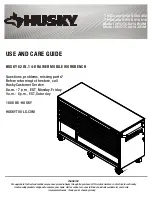
The SAS interface board has two external ports illustrated below. The supplied internal SAS cable
supports connection of two devices. Several cabling configurations are possible, but the following
cabling configuration is recommended to provide the most consistent layout between devices and
external connectors.
When two SAS devices are installed, the right–most connector of the internal cable is connected
to the device on the right and the left-most connector of the internal cable is connected to the device
on the left. This routes the right-hand device to external port 1 and the left-hand device to external
port 2.
Looking at the rack from the rear, the bottom external port is Port 1 and the top external port is
Port 2.
Figure 2 External SAS ports on the 3U rack-mount enclosure
•
When two full-height SAS devices are installed, the bottom–most connector of the internal
cable is connected to the device on the right and the top-most connector of the internal cable
is connected to the device on the left. This routes the right-hand device to external port 1 and
the left-hand device to external port 2.
•
When two half-height SAS devices are installed in the right-hand tray, the bottom–most
connector of the internal cable is connected to the device on the bottom of the right stack and
the top-most connector of the internal cable is connected to the device on the top of the right
stack. This routes the bottom right-hand device to external port 1 and the top right-hand device
to external port 2.
•
If four half-height SAS devices are installed, the second SAS interface board is required; an
additional enclosure internal cable is available. The cabling pattern is the same, with the
second card used to connect the devices in the left-hand tray.
NOTE:
The interface board has text, “Port 1–0” and “Port 2–0”, on the PCI board near the
internal SAS connector, which also helps identify the routing to the external ports.
SAS Cabling Recommendations
5






































